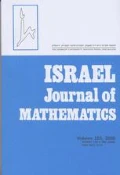Abstract
A permutation groupG of finite degreed is called a sharp permutation group of type {k},k a non-negative integer, if every non-identity element ofG hask fixed points and |G|=d−k. We characterize sharp non-abelianp-groups of type {k} for allk.
Similar content being viewed by others
References
N. Blackburn,On a special class of p-groups, Acta Mathematica100 (1958), 45–92.
C. Bonmassar and C. M. Scoppola,Normally constrained p-groups, Unione Matematica Italiana. Bollettino2-B (1999), 161–168.
P. J. Cameron,Permutation Groups, LMS Student Texts 45, Cambridge University Press, Cambridge, 1999.
C. Franchi,On permutation groups of finite type, European Journal of Combinatorics22 (2001), 821–837.
C. Franchi,Abelian sharp permutation groups, Journal of Algebra, to appear.
D. R. Hughes,Partial difference sets, American Journal of Mathematics78 (1956), 650–677.
E. I. Khukhro,Nilpotent Groups and their Automorphisms, W. de Gruyter, Berlin, New York, 1993.
R. Schmidt,Subgroup Lattices of Groups, W. de Gruyter, Berlin, New York, 1994.
Author information
Authors and Affiliations
Corresponding author
Rights and permissions
About this article
Cite this article
Franchi, C. Non-abelian sharp permutationp-groups. Isr. J. Math. 139, 157–175 (2004). https://doi.org/10.1007/BF02787546
Received:
Issue Date:
DOI: https://doi.org/10.1007/BF02787546



